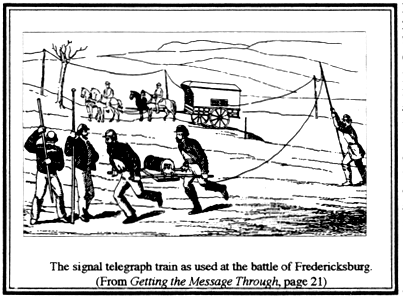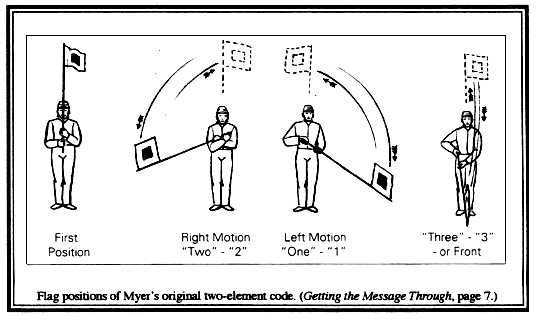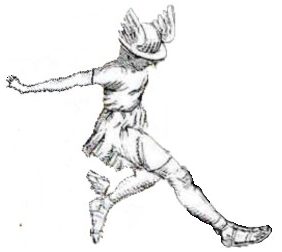
With the current media attention being given to the 1960s and the resurgence of interest in that era, it may be sobering for aging baby boomers to realize that they were not the first Sixties generation to experience a communications gap. In the 1860s, particularly during the American Civil War, military forces witnessed a widening communications chasm. The increased range and accuracy of rifled weapons, coupled with improvements in transportation, notably the railroad, expanded both the size of the battlefield and the theater of war. Meanwhile, military communications technology lagged behind. A commander could no longer control his troops through the sound of his voice alone, as armies grew larger and more complex. Traditional communications methods remained in use, but bugle calls and mounted messengers could not always get the message through or travel far enough, fast enough.
This dilemma spawned the establishment of the U.S. Army Signal Corps as a separate branch dedicated to the provision of military communications, the first of its kind. Although by the 1860s electric telegraphy had been available commercially for nearly twenty years, it had yet to be adapted adequately for military purposes. During the Mexican War (1846-1848), the quartermaster general of the U.S. Army used the telegraph to communicate between his office in Washington and depots in Baltimore, Philadelphia, and New York. But the telegraph’s reliability was such that he supplemented each telegram with a letter as a precautionary measure. Into the breach stepped a rather unlikely figure, an Army medical officer by the name of Albert J. Myer.
While serving as an Army doctor in Texas during the 1850s, Myer had developed a signaling system using flags by day and torches at night to send messages. This system, which became know as wigwag, employed a single flag or torch moved to one side and then the other of a central reference point. (The use of a single flag distinguished wigwag from semaphore signaling.) Messages were spelled out according to a two-element numerical code. A combination of numerals represented each letter of the alphabet (A=11, B=1221, etc.), and numerical values were assigned to the movements of the flag. A movement to the left of center indicated the numeral “1” and to the right of center, “2.” Dipping the flag forward one or more times signaled the end of a word, sentence, or message. The system was fairly easy to learn, and the equipment required was not elaborate. Under ideal conditions, a message could be wigwagged over distances of ten to fifteen miles at about three words per minute. But wigwag had some serious limitations: it required a line of sight between the sender and the receiver and could only be used in clear weather. Nevertheless, wigwag provided a simple and effective means of communications that was portable enough for tactical use on the battlefield.

After a period of testing, the War Department endorsed Myer’s system. On June 21, 1860-considered the birth date of the Signal Corps-Congress approved the addition of a signal office to the Army staff, and Myer received the appointment a few days later. Unfortunately, Congress did not provide any personnel to perform signaling duty, so Myer had to find and train assistants. He soon received orders to report to New Mexico, where he tested his signals in the field during a campaign against the Navajos. The results were successful. Myer and his men accompanied troops on campaigns, maintaining communications between the columns, performing reconnaissance, and reporting by signal. On January 29, 1861, Myer obtained U.S. Patent No. 31,256 for his signaling system, for which he had applied before leaving for the Southwest.
When the Civil War erupted, Myer faced a daunting task. With no assigned personnel, men had to be detailed to signal duty from their regular units. Ironically, many of the soldiers Myer had already trained joined the Confederate Army. Most prominent among them was Edward P. Alexander, who eventually became Lieutenant General James Longstreet’s chief of artillery. Alexander used his knowledge to introduce Myer’s system into the Confederate Army, thus making signal security a problem for both sides throughout the war. Congress did not authorize the creation of a Signal Corps for the Union Army until March 1863, with the intention that it would remain in existence only for the duration of the conflict. Myer became the head of the organization with the title Chief Signal Officer.
Although Myer had built his wigwag system around old technology, he was also looking ahead. He had worked in an electric telegraph office while attending medical school, and recognized the possibilities of that technology for battlefield signaling. Based on his rather broad mandate that placed him in charge “of all signal duty. . . and apparatus connected therewith,” Myer set out to adapt the electric telegraph to the Army’s signaling needs. Perhaps drawing upon his previous experience as a doctor with Army ambulances, Myer devised a so-called telegraph train for use in the field. This “train” was actually an animal-drawn wagon that carried telegraph instruments, poles, wires, and other necessary equipment. Eventually the Signal Corps put thirty of these trains in the field. To keep their operation simple, the Signal Corps’ telegraphs were adaptations of the Beardslee magneto-electric device that did not require knowing Morse code. The operator only needed to be able to read and write, so that he could turn the machine’s dial to the appropriate letters to produce a message. The Beardslee machines, however, were not very powerful and could only transmit signals from five to eight miles.
Ultimately, the Signal Corps lost a struggle within the Army for control over electric telegraphy with a rival agency known as the U. S. Military Telegraph. Actually composed of civilian telegraph operators working under military supervision, the Military Telegraph used more powerful commercial machines. Secretary of War Edwin M. Stanton took a proprietary interest in this organization and placed the telegraph office next to his own in the War Department, where he kept close watch over its operations. By the autumn of 1863, Myer had decided to convert the Beardslee machines to use Morse keys and sounders. By doing so, however, he placed himself in direct competition with the Military Telegraph for skilled personnel. Myer’s actions angered Stanton, who responded by removing Myer from his position as Chief Signal Officer and exiling him to duty in Memphis, Tennessee. In the aftermath, the Signal Corps retained its flag signaling responsibilities, but had to turn over its electrical equipment to the Military Telegraph.
With the end of the war, the Military Telegraph ceased to exist, but the Signal Corps remained alive. Myer eventually regained his position as Chief Signal Officer as well as control over electrical communications. But the Signal Corps’ mission remained rather vague, and many Army leaders did not yet view communications as a legitimate military specialty. Consequently, Myer successfully lobbied for the assignment of weather reporting duties to his branch.* Over the next decade, Signal Corps soldiers strung thousands of miles of telegraph lines in remote corners of the country to serve the communications needs of frontier settlers and to become part of the weather service’s network. They also erected lines along the eastern seaboard to assist the Life-Saving Service (the forerunner of the Coast Guard) and to function as a storm warning system. When Myer died in 1880, shortly after being promoted to brigadier general, he left behind a branch that had gained an equal status with the other bureaus in the War Department. In recognition of General Myer’s contributions, Fort Myer, Virginia, was named for him.
By the time of Myer’s death, electrical communications had all but eclipsed the Army’s use of wigwag flags. The communications gap was narrowing. During the late 1870s, the Signal Corps began adapting its telegraph lines for the telephone. The tele-phone’s widespread use in combat, however, did not occur until World War I. Meanwhile, wigwag’s last significant service in combat came during the Spanish-American War, when signal soldiers used flags to direct the fire of naval guns and to communicate between the convoys of troop transports sailing for Cuba. By the end of that conflict, the twentieth century was about to dawn along with a revolution in communications that General Myer could hardly have imagined . Yet, the Signal Corps’ founder would undoubtedly have found fascinating the present pervasiveness of telecommunications throughout society, as well as their integration into all aspects of military operations-from laser-guided “smart bombs” to the satellites of the global positioning system. In fact, the military’s increasing reliance on computers makes the potential threat from jammers and hackers a very serious problem. Ironically, however, the zeros and ones of a computer’s binary code are not all that different from Myer’s two-element signal code. The more things change. . . .
*Congress approved a joint resolution in February 1870 authorizing the Secretary of War to take meteorological observations at military posts and at other locations. The Secretary assigned the function to the Chief Signal Officer. The Signal Corps operated the weather bureau from 1870 to 1891. In 1890 Congress approved the transfer of the weather bureau to the Agriculture Department, and the change became effective on July 1, 1891.
Rebecca Raines has been a historian at the U.S. Army Center of Military History in Washington, D.C., for over twenty years. She is currently the acting chief of the Organizational History Branch. Her history of the Signal Corps, Getting the Message Through, was published by the Government Printing Office in 1996.

You must be logged in to post a comment.